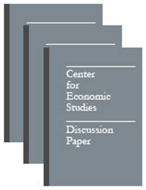Business Volatility, Job Destruction, and Unemployment
Business Volatility, Job Destruction, and Unemployment
Abstract
Unemployment inflows fell from 4 percent of employment per month in the early 1980s to 2 percent or less by the mid 1990s and thereafter. U.S. data also show a secular decline in the job destruction rate and the volatility of firm-level employment growth rates. We interpret this decline as a decrease in the intensity of idiosyncratic labor demand shocks, a key parameter in search and matching models of unemployment. According to these models, a lower intensity of idiosyncratic shocks produces less job destruction, fewer workers flowing through the unemployment pool and less frictional unemployment. To evaluate the importance of this theoretical mechanism, we relate industry-level unemployment flows from 1977 to 2005 to industry-level indicators for the intensity of idiosyncratic shocks. Unlike previous research, we focus on the lower frequency relationship of job destruction and business volatility to unemployment flows. We find strong evidence that declines in the intensity of idiosyncratic labor demand shocks drove big declines in the incidence and rate of unemployment. This evidence implies that the unemployment rate has become much less sensitive to cyclical movements in the job-finding rate.
Others in Series
Working Paper
Working Paper
Working Paper




